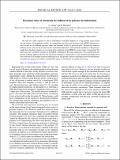| dc.contributor.author | Holcman, D. | |
| dc.contributor.author | Amitai, Assaf | |
| dc.date.accessioned | 2018-04-03T17:00:32Z | |
| dc.date.available | 2018-04-03T17:00:32Z | |
| dc.date.issued | 2018-03 | |
| dc.date.submitted | 2018-02 | |
| dc.identifier.issn | 2470-0045 | |
| dc.identifier.issn | 2470-0053 | |
| dc.identifier.uri | http://hdl.handle.net/1721.1/114509 | |
| dc.description.abstract | The time for a DNA sequence to find its homologous counterpart depends on a long random search inside the cell nucleus. Using polymer models, we compute here the mean first encounter time (MFET) between two sites located on two different polymer chains and confined locally by potential wells. We find that reducing tethering forces acting on the polymers results in local decondensation, and numerical simulations of the polymer model show that these changes are associated with a reduction of the MFET by several orders of magnitude. We derive here new asymptotic formula for the MFET, confirmed by Brownian simulations. We conclude from the present modeling approach that the fast search for homology is mediated by a local chromatin decondensation due to the release of multiple chromatin tethering forces. The present scenario could explain how the homologous recombination pathway for double-stranded DNA repair is controlled by its random search step. | en_US |
| dc.publisher | American Physical Society | en_US |
| dc.relation.isversionof | http://dx.doi.org/10.1103/PhysRevE.97.032417 | en_US |
| dc.rights | Article is made available in accordance with the publisher's policy and may be subject to US copyright law. Please refer to the publisher's site for terms of use. | en_US |
| dc.source | American Physical Society | en_US |
| dc.title | Encounter times of chromatin loci influenced by polymer decondensation | en_US |
| dc.type | Article | en_US |
| dc.identifier.citation | Amitai, A. and D. Holcman. "Encounter times of chromatin loci influenced by polymer decondensation." Physical Review E 97, 3 (March 2018): 032417 © 2018 American Physical Society | en_US |
| dc.contributor.department | Institute for Medical Engineering and Science | en_US |
| dc.contributor.department | Massachusetts Institute of Technology. Department of Chemical Engineering | en_US |
| dc.contributor.mitauthor | Amitai, Assaf | |
| dc.relation.journal | Physical Review E | en_US |
| dc.eprint.version | Final published version | en_US |
| dc.type.uri | http://purl.org/eprint/type/JournalArticle | en_US |
| eprint.status | http://purl.org/eprint/status/PeerReviewed | en_US |
| dc.date.updated | 2018-03-27T18:00:15Z | |
| dc.language.rfc3066 | en | |
| dc.rights.holder | American Physical Society | |
| dspace.orderedauthors | Amitai, A.; Holcman, D. | en_US |
| dspace.embargo.terms | N | en_US |
| dc.identifier.orcid | https://orcid.org/0000-0002-8594-6529 | |
| mit.license | PUBLISHER_POLICY | en_US |
